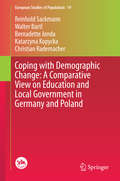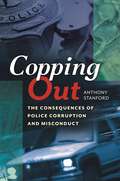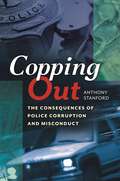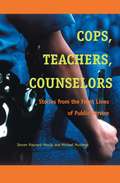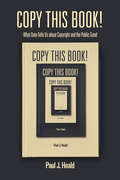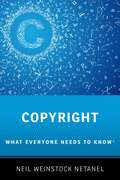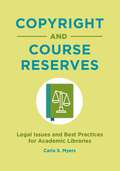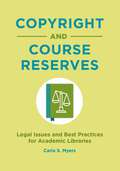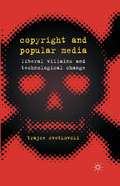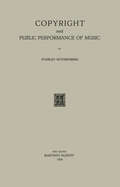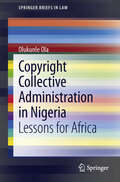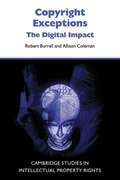- Table View
- List View
Coping with Demographic Change: A Comparative View On Education And Local Government In Germany And Poland (European Studies of Population #19)
by Reinhold Sackmann Walter Bartl Bernadette Jonda Katarzyna Kopycka Christian RademacherWith many OECD countries experiencing a decline in their populations, this book offers a theoretical model of coping with demographic change and examines different strategies that societies have used to come to terms with demographic change. In particular, it details the different ways that Germany and Poland have tried to cope with this challenge and reveals three conflicting strategies: expansion, reduction, and phasing out.Coverage includes:· How and why demographic change was used in Poland to expand the education system· The variance of linkage between demographic change and growth rates in different fields of education in a German Bundesland· Modes of reflexivity and personnel policy in German and Polish municipalities· Effects of demographic change and forms of coping on fiscal capacity and unemployment rates in German municipalitiesCoping with Demographic Change examines how and why societies cope with these detrimental effects. It conceptualizes the challenges a society faces as a result of demographic change and focuses on the processes by which actors, organizations and nation-states try to cope with this new situation.
Coping with Overloaded Criminal Justice Systems: The Rise of Prosecutorial Power Across Europe
by Jörg-Martin Jehle Marianne WadeThis book describes the results of a six-nation study of how criminal justice agencies in England and Wales, France, Germany, Netherlands, Poland, and Sweden have reacted to high crime rates and punitiveness. The book details how various solutions have been adopted, involving diversion of cases from courts, increases in financial penalties imposed by police or prosecutors without full court hearings and the introduction in some countries of "administrative offences".
Copping Out: The Consequences of Police Corruption and Misconduct
by Anthony StanfordA Chicago journalist reveals how pervasive police misconduct, brutality, and corruption are changing the perspective of the criminal justice system and eroding the morals of the American people.In this shocking yet fascinating volume, an award-winning Chicago journalist goes behind the headlines to provide a far-reaching analysis of brutality, vice, and corruption among men and women who have sworn to serve and protect. This timely book draws on actual cases to examine the widespread phenomenon of corruption inside law enforcement agencies. It looks at the effort of criminal elements and gangs to infiltrate police departments and the criminal justice system, and it discusses how vigilante justice is encouraged by claims of police misconduct. Of particular importance to readers, the book also exposes the trickle-down effect of police corruption as it affects American values and society as a whole.But the news is not all bad. Police departments across the nation are fighting back against abuse of power, and the author sheds light on the escalating battle they are waging against rogue police officers involved in criminal activity. Through Stanford's investigative work and firsthand interviews with leading law enforcement professionals, readers will be privy to the backstory of the struggle of police commands to insulate their departments against the criminality and corruption so prevalent today.
Copping Out: The Consequences of Police Corruption and Misconduct
by Anthony StanfordA Chicago journalist reveals how pervasive police misconduct, brutality, and corruption are changing the perspective of the criminal justice system and eroding the morals of the American people.In this shocking yet fascinating volume, an award-winning Chicago journalist goes behind the headlines to provide a far-reaching analysis of brutality, vice, and corruption among men and women who have sworn to serve and protect. This timely book draws on actual cases to examine the widespread phenomenon of corruption inside law enforcement agencies. It looks at the effort of criminal elements and gangs to infiltrate police departments and the criminal justice system, and it discusses how vigilante justice is encouraged by claims of police misconduct. Of particular importance to readers, the book also exposes the trickle-down effect of police corruption as it affects American values and society as a whole.But the news is not all bad. Police departments across the nation are fighting back against abuse of power, and the author sheds light on the escalating battle they are waging against rogue police officers involved in criminal activity. Through Stanford's investigative work and firsthand interviews with leading law enforcement professionals, readers will be privy to the backstory of the struggle of police commands to insulate their departments against the criminality and corruption so prevalent today.
Cops, Teachers, Counselors: Stories from the Front Lines of Public Service
by Steven Williams Maynard-Moody Michael Craig MushenoWhether on a patrol beat, in social service offices, or in public school classrooms, street-level workers continually confront rules in relation to their own beliefs about the people they encounter. Cops, Teachers, Counselors is the first major study of street-level bureaucracy to rely on storytelling. Steven Maynard-Moody and Michael Musheno collect the stories told by these workers in order to analyze the ways that they ascribe identities to the people they encounter and use these identities to account for their own decisions and actions. The authors show us how the world of street-level work is defined by the competing tensions of law abidance and cultural abidance in a unique study that finally allows cops, teachers, and counselors to voice their own views of their work. Steven Maynard-Moody is Director of the Policy Research Institute and Professor of Public Administration at the University of Kansas. Michael Musheno is Professor of Justice and Policy Studies at Lycoming College and Professor Emeritus of Justice Studies, Arizona State University.
Copy This Book!: What Data Tells Us about Copyright and the Public Good
by Paul J. HealdIn Copy This Book!, Paul J. Heald draws on a vast knowledge of copyright scholarship and a deep sense of irony to explain what's gone wrong with copyright in the twenty-first century. Distilling extensive empirical data to clearly show the implications of copyright laws and doctrine for public welfare, he illustrates his findings with lighthearted references to familiar (and obscure) works and their creators (and sometimes their creators' oddball relations). Among the questions he tackles: How does copyright deter composers from writing new songs? Why are so many famous photographs unprotected orphans, and how does Getty Images get away with licensing them? What can the use of music in movies tell us about the proper length of the copyright term? How do publishers get away with claiming rights in public domain works and extracting unmerited royalties from the public? Heald translates piles of data, complex laws, and mysterious economics, equipping readers with the tools for judging past and future copyright law.
Copyfraud and Other Abuses of Intellectual Property Law
by Jason MazzoneIntellectual property law in the United States does not work well and it needs to be reformed—but not for the reasons given by most critics. The issue is not that intellectual property rights are too easily obtained, too broad in scope, and too long in duration. Rather, the primary problem is overreaching by publishers, producers, artists, and others who abuse intellectual property law by claiming stronger rights than the law actually gives them. From copyfraud—like phony copyright notices attached to the U.S. Constitution—to lawsuits designed to prevent people from poking fun at Barbie, from controversies over digital sampling in hip-hop to Major League Baseball's ubiquitous restriction on sharing any "accounts and descriptions of this game," overreaching claims of intellectual property rights are everywhere. Overreaching interferes with legitimate uses and reproduction of a wide variety of works, imposes enormous social and economic costs, and ultimately undermines creative endeavors. As this book reveals, the solution is not to change the scope or content of intellectual property rights, but to create mechanisms to prevent people asserting rights beyond those they legitimately possess. While there are many other books on intellectual property, this is the first to examine overreaching as a distinct problem and to show how to solve it. Jason Mazzone makes a series of timely proposals by which government, organizations, and ordinary people can stand up to creators and content providers when they seek to grab more than the law gives them.
Copyright: What Everyone Needs to Know® (What Everyone Needs To Know®)
by Neil Weinstock NetanelCopyright law was once an esoteric backwater, the special province of professional authors, publishers, and media companies. This is no longer the case. In the age of social media and cloud storage, we have become a copying and sharing culture. Much of our everyday communication, work, and entertainment now directly involves copyright law. Copyright law and policy are ferociously contested. Record labels, movie studios, book publishers, newspapers, and many authors rage that those who share music, video, text, and images over the Internet are "stealing" their property. By contrast, copyright industry critics celebrate digital technology's potential to make the universe of movies, music, books, and art accessible anytime and anywhere - and to empower individuals the world over to express themselves by sharing and remixing those works. These critics argue that excessive copyright enforcement threatens that promise and stifles creativity. In Copyright: What Everyone Needs to Know®, Neil Netanel explains the concepts needed to understand the heated debates about copyright law and policy. He identifies the combatants, unpacks their arguments, and illuminates what is at stake in the debates over copyright's present and future.
Copyright and Course Reserves: Legal Issues and Best Practices for Academic Libraries
by Carla S. MyersWith the guidance of this book, academic librarians wishing to provide print, electronic, and streaming media (music and film) course reserve services for their campus communities can do so in compliance with U.S. copyright law.Many academic libraries offer print and electronic course reserve services that encourage learning by connecting students and faculty with less expensive and supplementary educational materials. Unfortunately, there are many misconceptions regarding how U.S. copyright law affects course reserve services; as a result, many academic libraries restrict the scope of the services they provide or refrain from pursuing new options, such as media reserves, out of fear of violating the law or being sued for copyright infringement. Copyright and Course Reserves addresses this problem, providing authoritative advice for making print, electronic, and media course reserves available in compliance with U.S. copyright law. It explains options for implementing and sustaining media reserve services through which students and faculty can access online music, sound recordings, and film. Additionally, short examples from a wide range of libraries explore real-world scenarios and current issues related to course reserve services to help readers better understand and apply the information found in the book.
Copyright and Course Reserves: Legal Issues and Best Practices for Academic Libraries
by Carla S. MyersWith the guidance of this book, academic librarians wishing to provide print, electronic, and streaming media (music and film) course reserve services for their campus communities can do so in compliance with U.S. copyright law.Many academic libraries offer print and electronic course reserve services that encourage learning by connecting students and faculty with less expensive and supplementary educational materials. Unfortunately, there are many misconceptions regarding how U.S. copyright law affects course reserve services; as a result, many academic libraries restrict the scope of the services they provide or refrain from pursuing new options, such as media reserves, out of fear of violating the law or being sued for copyright infringement. Copyright and Course Reserves addresses this problem, providing authoritative advice for making print, electronic, and media course reserves available in compliance with U.S. copyright law. It explains options for implementing and sustaining media reserve services through which students and faculty can access online music, sound recordings, and film. Additionally, short examples from a wide range of libraries explore real-world scenarios and current issues related to course reserve services to help readers better understand and apply the information found in the book.
Copyright and Fan Productivity in China: A Cross-jurisdictional Perspective
by Tianxiang HeThis book takes a unique approach to mitigate the problem of massive online copyright infringement and justify fan activities. It argues for a cooperative approach that encourages copyright owners to exert a degree of control over their fan creators. In contrast to the current approach, which treats fan utilizations as theft, this book suggests that the copyright owners and the lawmakers should instead distinguish between fan creators and commercial pirates, allowing them unleash their potential. This book offers a clear and comprehensive account of the fascinating aspects of legal problems created by fan activities in China, Japan and the United States, offering a valuable guide for students, practitioners, academics and entrepreneurs whose work involves or who are interested in cutting-edge legal issues in the creative industry. "Tianxiang He introduces us to the world of fandom inhabited by ‘fan-subbers’, fan-dubbers’, ‘mash-uppers’, and ‘fan-fictionists’ against the backdrop of copyright law and policy in China. His work is engaging in that it not merely describes the law, but also the political dimension where copyright and state media control converge into a reality where being an artist or a fan is not that straightforward." -- Prof. Anselm Kamperman Sanders, Institute for Globalization and International Regulation (IGIR), Faculty of Law, Maastricht University "The tension between copyright holders and fan communities has been increasingly salient yet underexplored. This timely, insightful and deeply engaging book not only fills a niche, but also covers a country that has been rarely examined in this context. The book advances a promising model for the two groups to cooperate. It also explores complex issues concerning political culture, media regulation and civic engagement in China. A must read for anybody interested in copyright law, cultural production, digital technology or Chinese information policy." -- Prof. Peter K. Yu, Professor of Law and Director, Center for Law and Intellectual Property, Texas A&M University School of Law
Copyright and Fundamental Rights in the Digital Age: A Comparative Analysis in Search of a Common Constitutional Ground
This timely and thought-provoking book explores how the protection of copyright in the digital age requires a reconsideration of how this is balanced with other fundamental rights and freedoms. Analysing the impact of the rise of digital technologies and the internet on copyright regimes, it particularly focuses on the effects of recent reforms to the EU’s legal framework for the protection and enforcement of copyright. Taking a comparative approach, contributions from both leading and emerging scholars offer a variety of perspectives and methodologies through which to examine copyright law in the context of the digital economy. They investigate issues such as the relationship between private and public enforcement mechanisms, the parallels and divergences between US and European approaches, and the influence of the Court of Justice of the EU and the European Court of Human Rights on national courts and the European legal regime. Scholars of comparative and European law, as well as those with a particular interest in copyright in the context of digital technologies will find this an essential read. It will also prove useful to practitioners looking to understand recent trends in the interpretation of the EU legal framework around copyright.
Copyright and Information Privacy: Conflicting Rights in Balance
by Federica GiovanellaFederica Giovanella examines the on-going conflict between copyright and informational privacy rights within the judicial system in this timely and intriguing book. Adopting a comparative approach focusing on the United States, Canada and Italy, Dr Giovanella skilfully explores the strategies through which judges solve conflicts between Internet users’ data protection and copyright holders’ enforceable rights. Using research centred on a selection of lawsuits in which copyright holders attempted to enforce their rights against Internet users suspected of illegal file-sharing, this book analyses the cases and regulatory frameworks concerning both privacy and copyright. Copyright and Information Privacy demonstrates that these decisions were ultimately the by-products of different policy conceptions of the two conflicting rights. Whilst providing a comprehensive analysis of the conflict between copyright and data protection, this book also stimulates the debate surrounding the role that judges have in balancing conflicting rights, and examines their reasoning in resolving such conflict, taking into consideration the process of conceptual balancing. Perceptive and contemporary in topic, this book will be beneficial to both scholars and students of intellectual property, privacy and comparative law.
Copyright and Popular Media: Liberal Villains and Technological Change
by T. CvetkovskiCopyright governance is in a state of flux because the boundaries between legal and illegal consumption have blurred. Trajce Cvetkovski interrogates the disorganizational effects of piracy and emerging technologies on the political economy of copyright in popular music, film and gaming industries.
Copyright and Public Performance of Music
by Stanley RothenbergThere have been many notable descriptions of music but perhaps one of the most apt from the viewpoint of law and commerce was Ian Hay's statement, "Music is about the most vulnerable piece of property that a man can bring into the world, especially today. " With the increased use of music brought about by technological advances, such as radio, sound films and tele vision, and the concomitant decrease in the sale of sheet music and phonograph records, the need for writers and publishers of music to share in the revenue from public performances became urgent. With this urgency the author's rights in the public per formance of his music became the subject of much literature and litigation which continues to this day. The purpose of this book is to present a clear picture of this much written and litigated about subject: the au'thor's right in the public performance of his music. In order to do this we must indicate not only the nature of the right but also how it is exer cised for it should be evident that with performances taking place throughout the world and in a multitude of ways, the exercise of the right by an individual author or publisher would present insurmountable problems.
Copyright and the Challenge of the New (Information Law Series #25)
by Brad Sherman Leanne WisemanCopyright is not, as is often thought, something that is periodically ‘extended’ to cover a new field or medium; rather, copyright redefines itself whenever its efficacy is challenged. While many factors have contributed to this process, the most consistent has been the challenges created by new technologies. The contributing authors build upon this insight to show that copyright law is, and has always been, a creature of technology. Each chapter focuses on a specific technology or group of technologies – photography, telegraphy, the phonogram, radio, film, the photocopier, the tape player, television, and computer programs – emphasizing the changes that each technology instigated and the challenges and opportunities it created. Perhaps the most profound insight of this extraordinary book is the authors’ claim – ably supported in a series of intriguing chapters – that the way the law responds and reacts to new technologies is always mediated by the political, social, economic, and cultural environment in which the interaction occurs. For example, these chapters describe and explain how: statutory schemes of remuneration arose from failures to effectively police new forms of piracy; persistent litigation and lobbying by copyright owners forces legislatures and courts to devise new laws; content (e.g., sporting events) generates new rules of access to broadcasts; and ‘fair copying’ (e.g., by libraries) is the necessary exception that proves the rule. As well as providing insight into the ways that copyright law interacted with old technologies when they were new, the book also offers important insights into problems and issues currently confronting copyright law and policy such as the appropriate scope of copyright and the relation between copyright and the public interest. With the broad perspectives opened by these essays, academics, practitioners and policymakers in the field will find themselves well equipped to deal with the problems that will inevitably be created by technologies in the future.
Copyright and the Court of Justice of the European Union
by Eleonora RosatiThis title focuses specifically on the role, action, and legacy of the Court of Justice of the European Union (CJEU) in the field of copyright, also by providing an exclusive survey that covers two decades (1998 - 2018) of CJEU decisions in this area of the law. The main objective of this work is providing readers with a sense of direction of EU copyright case law. In order to achieve this, an attempt of 'tidying up' and rationalizing existing rulings is carried out. The book consists of three parts. The first part explores the role of the CJEU in copyright cases. Besides outlining the history of EU copyright harmonization and providing statistical data concerning the Court's activity, it extracts the key standards employed in copyright case law, explains their meaning and significance, and carries out a novel statistical analysis aimed at mapping relations between the various standards. Following a discussion of the impact of CJEU interpretation of certain EU copyright provisions (notably their preemptive force on individual EU Member States' freedom), the second part is concerned with CJEU action (and vision) in respect of three key areas of copyright: the construction of economic rights; exceptions and limitations; and enforcement. The final part focuses on CJEU legacy broadly intended. It tackles two distinct perspectives, these being the effect on national copyright laws and the current policy discourse around EU copyright reform. As regards the former, the book discusses the default consequences of the departure of a certain Member State from the EU. In relation to the latter, attention is focused on a number of selected areas, which require to be considered in light, not just of existing legislation, but also - and perhaps most importantly - existing case law.
Copyright and the Court of Justice of the European Union
by Eleonora RosatiThis title focuses specifically on the role, action, and legacy of the Court of Justice of the European Union (CJEU) in the field of copyright, also by providing an exclusive survey that covers two decades (1998 - 2018) of CJEU decisions in this area of the law. The main objective of this work is providing readers with a sense of direction of EU copyright case law. In order to achieve this, an attempt of 'tidying up' and rationalizing existing rulings is carried out. The book consists of three parts. The first part explores the role of the CJEU in copyright cases. Besides outlining the history of EU copyright harmonization and providing statistical data concerning the Court's activity, it extracts the key standards employed in copyright case law, explains their meaning and significance, and carries out a novel statistical analysis aimed at mapping relations between the various standards. Following a discussion of the impact of CJEU interpretation of certain EU copyright provisions (notably their preemptive force on individual EU Member States' freedom), the second part is concerned with CJEU action (and vision) in respect of three key areas of copyright: the construction of economic rights; exceptions and limitations; and enforcement. The final part focuses on CJEU legacy broadly intended. It tackles two distinct perspectives, these being the effect on national copyright laws and the current policy discourse around EU copyright reform. As regards the former, the book discusses the default consequences of the departure of a certain Member State from the EU. In relation to the latter, attention is focused on a number of selected areas, which require to be considered in light, not just of existing legislation, but also - and perhaps most importantly - existing case law.
Copyright and the Court of Justice of the European Union
by Eleonora RosatiFirst released in early 2019, Copyright and the Court of Justice of the European Union remains the only book exclusively devoted to the case law of the Court of Justice of the European Union (CJEU) in the EU copyright field. Fully updated for the new edition, the book explains the Court's role and action in the field of EU copyright law and provides readers with a sense of the direction of the Court's jurisprudence through an exercise of 'tidying up' and rationalizing the rulings issued so far. In his foreword to the first edition, First Advocate General Maciej Szpunar praised the book's 'profound analysis' of the EU copyright protection and CJEU decisions, which in his view, 'unveiled new information, perhaps never considered, even by members of the Court'. The new edition captures all the significant developments in EU copyright law that have occurred since 2019. Aside from macro-events such as the UK's now completed departure from the EU and the adoption of the Digital Single Market Directive (2019/790), seminal judgments have been issued by the CJEU which touch upon all the main foundational aspects of EU copyright. This book is structured in three parts. The first part is about the role of the CJEU as an EU institution. Following a discussion of the impact of CJEU interpretation of EU copyright provisions (notably their pre-emptive effect on individual EU Member States' freedom), the second part is concerned with CJEU action and vision in respect of four key areas of copyright and related rights: the requirements for protection, construction of exclusive rights, exceptions and limitations, and enforcement. The final part focuses on the legacy of CJEU case law broadly intended, having regard to both individual countries' copyright laws (specifically: the UK) and recent EU copyright reform discourse, notably in the context of the DSM Directive. Timely and engaging, Copyright and the Court of Justice of the European Union provides novel insights into the activity of the CJEU in the copyright field and reflects on the resulting implications for the present and future of EU copyright.
Copyright and the Court of Justice of the European Union
by Eleonora RosatiFirst released in early 2019, Copyright and the Court of Justice of the European Union remains the only book exclusively devoted to the case law of the Court of Justice of the European Union (CJEU) in the EU copyright field. Fully updated for the new edition, the book explains the Court's role and action in the field of EU copyright law and provides readers with a sense of the direction of the Court's jurisprudence through an exercise of 'tidying up' and rationalizing the rulings issued so far. In his foreword to the first edition, First Advocate General Maciej Szpunar praised the book's 'profound analysis' of the EU copyright protection and CJEU decisions, which in his view, 'unveiled new information, perhaps never considered, even by members of the Court'. The new edition captures all the significant developments in EU copyright law that have occurred since 2019. Aside from macro-events such as the UK's now completed departure from the EU and the adoption of the Digital Single Market Directive (2019/790), seminal judgments have been issued by the CJEU which touch upon all the main foundational aspects of EU copyright. This book is structured in three parts. The first part is about the role of the CJEU as an EU institution. Following a discussion of the impact of CJEU interpretation of EU copyright provisions (notably their pre-emptive effect on individual EU Member States' freedom), the second part is concerned with CJEU action and vision in respect of four key areas of copyright and related rights: the requirements for protection, construction of exclusive rights, exceptions and limitations, and enforcement. The final part focuses on the legacy of CJEU case law broadly intended, having regard to both individual countries' copyright laws (specifically: the UK) and recent EU copyright reform discourse, notably in the context of the DSM Directive. Timely and engaging, Copyright and the Court of Justice of the European Union provides novel insights into the activity of the CJEU in the copyright field and reflects on the resulting implications for the present and future of EU copyright.
Copyright as a Constraint on Creating Technological Value (Law, Governance and Technology Series #63)
by Kasper DrazewskiCan we regulate something that doesn’t exist yet? Can Europe create its own Silicon Valley? Who gets to create technological value in today’s world? Whatever happened to the once-flourishing idea of rags to riches? Will new and exciting innovations only ever come from big tech companies? Can the EU establish its own flexible framework for boosting innovation, e.g. by facilitating the transformative use of technologies and data?This book seeks to answer these questions by exploring the differences in copyright culture in Europe and the United States, with its flexible fair use framework. The findings are anything but obvious, and decades of case law on both sides of the Atlantic tell a story of judges going to great lengths to deal with new challenges while navigating the imperfections of statutory law – both where it is too broadly formulated and where it is too prescriptive.How can the population’s creative potential best be fostered? What do software innovations have in common with the evolution of living organisms? What are the vulnerabilities of distributed creativity? Answers are sought in the processes that came into being during the early years of the digital revolution and were then forced to take a back seat as control of the means of production was increasingly placed in the hands of tech companies. The findings and insights presented here are highly relevant for today’s digital policymaking. Market concentration processes in innovation haven’t ceased; they are ongoing. And in an age where data-driven services are creating and reinforcing global oligopolies, the question posed by the U.S. Supreme Court in Google v. Oracle is now more relevant than ever: who should hold the keys to digital innovation?
Copyright Beyond Law: Regulating Creativity in the Graffiti Subculture
by Marta IljadicaThe form of graffiti writing on trains and walls is not accidental. Nor is its absence on cars and houses. Employing a particular style of letters, choosing which walls and trains to write on, copying another writer, altering or destroying another writer's work: these acts are regulated within the graffiti subculture. Copyright Beyond Law presents findings from empirical research undertaken into the graffiti subculture to show that graffiti writers informally regulate their creativity through a system of norms that are remarkably similar to copyright.The 'graffiti rules' and their copyright law parallels include: the requirement of writing letters (subject matter) and appropriate placement (public policy and morality exceptions for copyright subsistence and the enforcement of copyright), originality and the prohibition of copying (originality and infringement by reproduction), and the prohibition of damage to another writer's works (the moral right of integrity). The intersection between the 'graffiti rules' and copyright law sheds light on the creation of subculture-specific commons and the limits of copyright law in incentivising and regulating the production and location of creativity.
Copyright Beyond Law: Regulating Creativity in the Graffiti Subculture
by Marta IljadicaThe form of graffiti writing on trains and walls is not accidental. Nor is its absence on cars and houses. Employing a particular style of letters, choosing which walls and trains to write on, copying another writer, altering or destroying another writer's work: these acts are regulated within the graffiti subculture. Copyright Beyond Law presents findings from empirical research undertaken into the graffiti subculture to show that graffiti writers informally regulate their creativity through a system of norms that are remarkably similar to copyright.The 'graffiti rules' and their copyright law parallels include: the requirement of writing letters (subject matter) and appropriate placement (public policy and morality exceptions for copyright subsistence and the enforcement of copyright), originality and the prohibition of copying (originality and infringement by reproduction), and the prohibition of damage to another writer's works (the moral right of integrity). The intersection between the 'graffiti rules' and copyright law sheds light on the creation of subculture-specific commons and the limits of copyright law in incentivising and regulating the production and location of creativity.
Copyright Collective Administration in Nigeria: Lessons for Africa (SpringerBriefs in Law)
by Olukunle OlaThis work explores the operation and regulation of copyright collective management in Nigeria. The nexus between creativity and copyright and how creativity has played a pivotal role in development is explained. The need to balance the interests of authors and users is discussed and the societies representing the interest of copyright owners are illustrated.Further, Nigeria’s legal framework for collective management is enunciated from a pre-independence and post-independence perspective. In the course of this regulatory challenges encountered in the administration of collective management organizations, steps so far taken to address the problems, legislative reforms and judicial decisions are discussed.A path to the new regime is chartered. The South African Copyright collective management system is explored and a comparison between the Nigerian and South African system is made. Thereby the need for supervisory and regulatory agencies of government is shown to seek the national interest regarding the collective administration of copyright and related rights. Then, suggestions for improvement and lessons for Africa are provided.
Copyright Exceptions: The Digital Impact (PDF)
by Robert Burrell Allison ColemanThis book was first published in 2005. Copyright 'exceptions' or 'users' rights' have become a highly controversial aspect of copyright law. Most recently, Member States of the European Union have been forced to amend their systems of exceptions so as to comply with the Information Society Directive. Taking the newly amended UK legislation as a case study, this book examines why copyright exceptions are necessary and the forces that have shaped the present legislative regime in the UK. It seeks to further our understanding of the exceptions by combining detailed doctrinal analysis with insights gained from a range of other sources. The principal argument of the book is that the UK's current system of 'permitted acts' is much too restrictive and hence is in urgent need of reform, but that paradoxically the Information Society Directive points the way towards a much more satisfactory approach.
